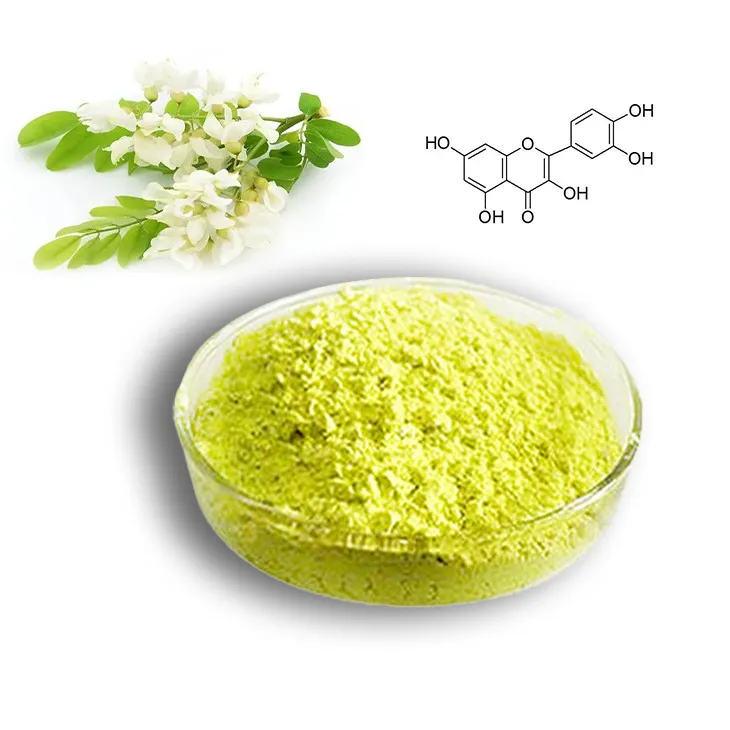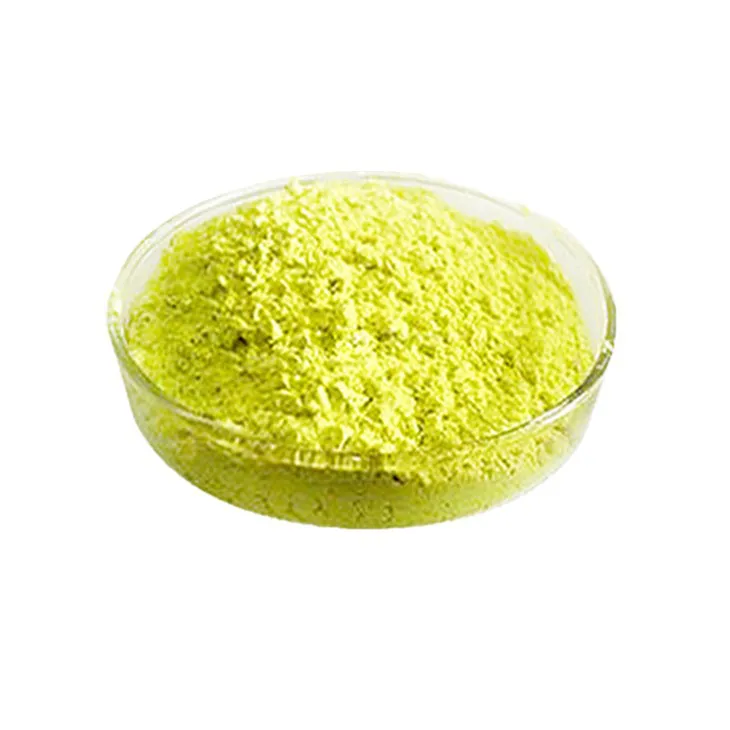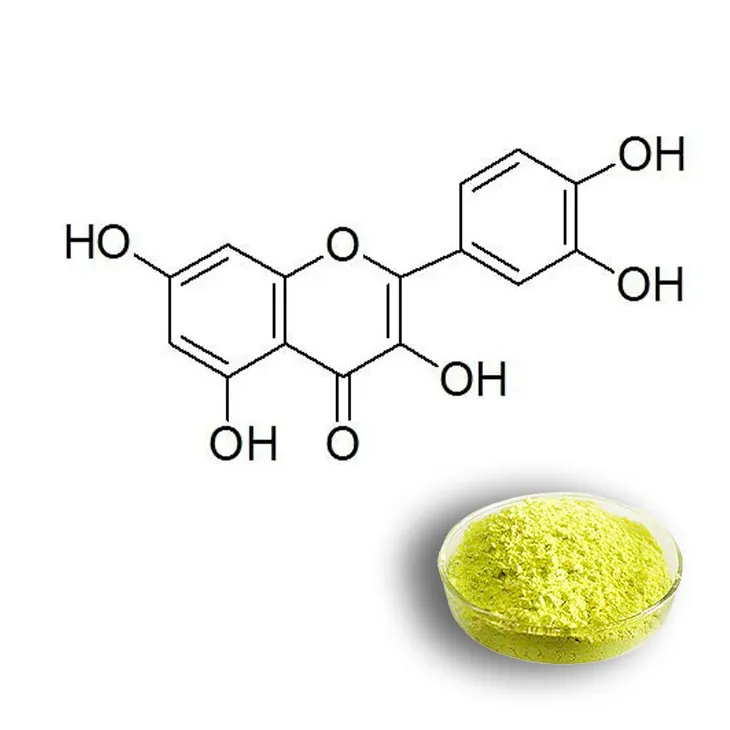- 0086-571-85302990
- sales@greenskybio.com
Trace component: organic quercetin.
2024-11-29

1. Introduction
Organic Quercetin is a fascinating trace component that has been drawing increasing attention in recent years. Trace components are substances that are present in relatively small amounts but can have significant impacts on various biological processes. Quercetin, in particular, stands out due to its diverse range of properties and potential applications.

2. Chemical Structure and Properties
2.1 Chemical Structure
Quercetin has a rather complex chemical structure. It is a flavonoid, which is a type of polyphenolic compound. Its chemical formula is \(C_{15}H_{10}O_{7}\). The structure consists of two benzene rings connected by a three - carbon chain with an oxygen - containing heterocyclic ring. This unique structure is what endows quercetin with its special properties.
2.2 Antioxidant Capabilities
One of the most important properties of organic quercetin is its antioxidant capacity. Antioxidants are substances that can neutralize free radicals in the body. Free radicals are highly reactive molecules that can cause damage to cells, proteins, and DNA. Quercetin can scavenge free radicals through various mechanisms. For example, it can donate hydrogen atoms to stabilize free radicals, thereby preventing them from causing oxidative stress. This antioxidant activity is crucial for maintaining the overall health of the body.
3. Sources of Organic Quercetin
Organic quercetin is found in a wide variety of plants.
3.1 Fruits
- Apples: Apples are a common source of quercetin. The skin of apples contains a relatively high amount of this flavonoid. Eating apples regularly can provide a certain amount of quercetin intake. - Berries: Berries such as blueberries, raspberries, and strawberries also contain quercetin. These fruits are not only delicious but also rich in nutrients and health - promoting compounds, with quercetin being one of them.3.2 Vegetables
- Onions: Onions are a well - known source of quercetin. The outer layers of onions usually have a higher concentration of this compound. Cooking onions may affect the availability of quercetin to some extent, but it still remains a significant dietary source. - Leafy Greens: Some leafy green vegetables like kale and spinach also contain small amounts of quercetin. Incorporating these vegetables into the diet can contribute to the overall intake of quercetin.3.3 Herbs and Spices
- Ginger: Ginger contains quercetin among other beneficial compounds. It has been used for centuries in traditional medicine for its various health - promoting properties, and quercetin may play a part in these effects. - Turmeric: Turmeric, which is famous for its active ingredient Curcumin, also contains quercetin. The combination of different bioactive compounds in turmeric may have synergistic effects on health.
4. Role in Human Health
4.1 Impact on the Body's Defense Mechanisms
Organic quercetin can enhance the body's defense mechanisms in several ways. Firstly, its antioxidant property helps to protect cells from oxidative damage, which is important for the proper functioning of the immune system. By reducing oxidative stress, quercetin can support the activity of immune cells such as white blood cells. Secondly, quercetin has been shown to have anti - inflammatory effects. Inflammation is a natural response of the body to injury or infection, but chronic inflammation can lead to various health problems. Quercetin can modulate the inflammatory response by inhibiting the production of certain inflammatory mediators.
4.2 Potential in Preventing Chronic Diseases
- Cardiovascular Diseases: Quercetin may play a role in preventing cardiovascular diseases. It can help to lower blood pressure by relaxing blood vessels. Additionally, it may reduce the levels of LDL (low - density lipoprotein) cholesterol, also known as "bad" cholesterol, and prevent the oxidation of LDL, which is a key step in the development of atherosclerosis. - Cancer: Some studies have suggested that quercetin may have anti - cancer properties. It can interfere with the growth and spread of cancer cells by various mechanisms, such as inducing apoptosis (programmed cell death) in cancer cells and inhibiting angiogenesis (the formation of new blood vessels that supply tumors). However, more research is needed to fully understand its potential in cancer prevention and treatment. - Diabetes: In relation to diabetes, quercetin may help to improve insulin sensitivity. By enhancing the body's response to insulin, it can contribute to better blood sugar control. This is particularly important for individuals with type 2 diabetes.
5. Applications in the Food and Pharmaceutical Industries
5.1 Food Industry
- Functional Foods: Quercetin is being increasingly used in the development of functional foods. These are foods that not only provide basic nutrition but also offer additional health benefits. For example, quercetin - enriched juices or snacks are becoming popular as they are perceived as a convenient way to boost the intake of this beneficial compound. - Food Preservation: Due to its antioxidant properties, quercetin can also be used in food preservation. It can help to prevent the oxidation of fats and oils in food products, thereby extending their shelf life.5.2 Pharmaceutical Industry
- Nutraceuticals: Quercetin is often formulated as a nutraceutical, which is a product that lies between a food and a drug. Nutraceuticals containing quercetin are sold as dietary supplements, usually in the form of tablets or capsules. They are intended to provide health benefits beyond basic nutrition. - Drug Development: There is also ongoing research into the use of quercetin as a potential drug ingredient. Scientists are exploring its use in the treatment of various diseases, such as those mentioned above. However, more studies are required to determine its safety and efficacy at higher doses for pharmaceutical applications.6. Conclusion
In conclusion, organic quercetin is a remarkable trace component with multiple benefits. Its complex chemical structure gives it potent antioxidant capabilities. It is sourced from a variety of plants and plays a crucial role in human health. It can impact the body's defense mechanisms and has potential in preventing chronic diseases. Moreover, it has diverse applications in the food and pharmaceutical industries. However, further research is still needed to fully understand its mechanisms of action, optimize its use in different applications, and ensure its safety at various levels of consumption.
FAQ:
What is the chemical structure of organic quercetin?
Organic quercetin has a rather complex chemical structure. It is a flavonoid compound, which contains multiple phenolic hydroxyl groups. This unique structure is what gives it strong antioxidant properties, allowing it to scavenge free radicals effectively in the body.
Which plants are the main sources of organic quercetin?
Organic quercetin can be sourced from a variety of plants. Some of the common ones include onions, apples, berries (such as blueberries and cranberries), and certain types of tea (like green tea). These plants contain quercetin in different amounts, and it can be extracted for various uses.
How does organic quercetin enhance the body's defense mechanisms?
At the trace level, organic quercetin enhances the body's defense mechanisms mainly through its antioxidant activity. It scavenges free radicals that can cause damage to cells and DNA. Additionally, it can modulate the immune system, for example, by influencing the activity of immune cells like macrophages and lymphocytes, helping the body better defend against pathogens and foreign substances.
What are the potential applications of organic quercetin in preventing chronic diseases?
Organic quercetin shows potential in preventing chronic diseases in several ways. For cardiovascular diseases, it may help reduce inflammation in blood vessels, lower blood pressure, and improve lipid profiles. In cancer prevention, it can inhibit the growth and spread of cancer cells through various molecular mechanisms. It may also play a role in preventing neurodegenerative diseases like Alzheimer's by reducing oxidative stress in the brain.
How is organic quercetin used in the food and pharmaceutical industries?
In the food industry, organic quercetin can be used as a natural antioxidant to extend the shelf - life of products. It can also be added to functional foods and dietary supplements due to its health - promoting properties. In the pharmaceutical industry, it is being studied for the development of drugs to treat various diseases. For example, it may be formulated into drugs for anti - inflammatory or anti - cancer purposes.
Related literature
- Quercetin: A Promising Molecule for Health Benefits"
- "The Role of Organic Quercetin in Plant - Based Medicine"
- "Quercetin: From Plant Sources to Therapeutic Applications"
- ▶ Hesperidin
- ▶ Citrus Bioflavonoids
- ▶ Plant Extract
- ▶ lycopene
- ▶ Diosmin
- ▶ Grape seed extract
- ▶ Sea buckthorn Juice Powder
- ▶ Fruit Juice Powder
- ▶ Hops Extract
- ▶ Artichoke Extract
- ▶ Mushroom extract
- ▶ Astaxanthin
- ▶ Green Tea Extract
- ▶ Curcumin
- ▶ Horse Chestnut Extract
- ▶ Other Product
- ▶ Boswellia Serrata Extract
- ▶ Resveratrol
- ▶ Marigold Extract
- ▶ Grape Leaf Extract
- ▶ New Product
- ▶ Aminolevulinic acid
- ▶ Cranberry Extract
- ▶ Red Yeast Rice
- ▶ Red Wine Extract
-
Dan Shen Root Extract/Salvia Root Extract
2024-11-29
-
Ivy Extract
2024-11-29
-
Lemon Extract
2024-11-29
-
Mango flavored powder
2024-11-29
-
Bilberry Extract
2024-11-29
-
Buckthorn bark extract
2024-11-29
-
Konjac Powder
2024-11-29
-
Jujube Extract
2024-11-29
-
Hedyotis Diffusa Extract
2024-11-29
-
Bitter Melon Extract
2024-11-29





















